Chemical Coordination Multiple-Choice Questions
Question 1. A decrease in blood pressure/volume will not cause the release of—
- Atrial Natriuretic Factor
- Aldosterone
- ADH
- Renin
Answer: 1. Atrial Natriuretic Factor
Question 2. A hypothalamic hormone, needed in
- The anterior pituitary gland stimulates the secretion of LH and FSH
- The posterior pituitary gland stimulates the secretion of oxytocin and FSH
- The posterior pituitary gland stimulates the secretion of LH and relaxin
- The anterior pituitary gland stimulates the secretion of LH and oxytocin
Answer: 1. Anterior pituitary gland stimulates the secretion of LH and FSH
Read and Learn More WBCHSE Multiple Choice Question and Answers for Class 11 Biology
Question 3. Hypersecretion of Growth Hormone in adults does not cause further increase in height because—
- Epiphyseal plates close after adolescence
- Bones lose their sensitivity to Growth Hormone in adults
- Muscle fibers do not grow in size after birth
- Growth Hormone becomes inactive in adults
Answer: 1. Epiphyseal plates close after adolescence
Question 4. Changes in GnRH pulse frequency in females are controlled by circulating levels of—
- Oestrogen and inhibin
- Progesterone only
- Progesterone and inhibin
- Oestrogen and progesterone
Answer: 4. Oestrogen and progesterone
| Class 11 Biology | Class 11 Chemistry |
| Class 11 Chemistry | Class 11 Physics |
| Class 11 Biology MCQs | Class 11 Physics MCQs |
| Class 11 Biology | Class 11 Physics Notes |
Chemical coordination and integration multiple choice questions with answers PDF
Question 5. Identify the correct statement on ‘inhibin’—
- Is produced by granulosa cells in the ovary and inhibits the secretion of FSH
- Is produced by granulosa cells in
- Is produced by nurse cells in the testes and inhibits the secretion of LH
- Inhibits the secretion of LH, FSH, and prolactin
Answer: 1. Is produced by granulosa cells in the ovary and inhibits the secretion of FSH
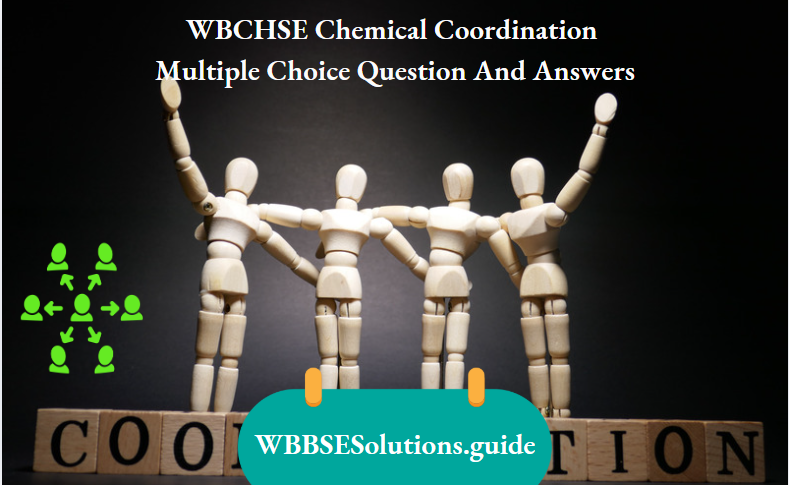
Question 6. Select the incorrect statement—
- LH and FSH trigger ovulation in the ovary
- LH and FSH decrease gradually during the follicular phase
- LH triggers the secretion of androgens from the Leydig cells
- FSH stimulates the Sertoli cells which help in spermiogenesis.
Answer: 2. LH and FSH decrease gradually during the follicular phase
Question 7. The amino acid, tryptophan is the precursor for the synthesis of—
- Thyroxine and triiodothyronine
- Oestrogen and progesterone
- Cortisol and cortisone
- Melatonin and serotonin
Answer: 4. Melatonin and serotonin
Question 8. Which of the following pairs of hormones are not antagonistic (having opposite effects) to each other?
- Insulin—Glucagon
- Aldosterone—Atrial natriuretic factor
- Relaxin—Inhibin
- Parathormone—Calcitonin
Answer: 3. Relaxin—Inhibin
MCQ on chemical coordination and integration for NEET with answers
Question 9. Which hormones stimulate the production of pancreatic juice and bicarbonate?
- Angiotensin and epinephrine
- Gastrin and insulin
- Cholecystokinin and secretin
- Insulin and glucagon
Answer: 3. Cholecystokinin and secretin
Question 10. Name a peptide hormone that acts mainly on hepatocytes, and adipocytes and enhances cellular glucose uptake and utilisation.
- Insulin
- Glucagon
- Secretin
- Gastrin
Answer: 1. Insulin
Question 11. The posterior pituitary gland is not a ‘true’ endocrine gland because—
- It is provided with a duct
- It only stores and releases hormones
- It is under the regulation of the hypothalamus
- It secretes enzymes
Answer: 2. It only stores and releases hormones
Question 12. several hormones like hCG, hPL, estrogen and progesterone are produced by—
- Ovary
- Placenta
- Fallopian tube
- Pituitary
Answer: 2. Placenta
Class 11 biology chemical coordination and integration MCQ with solutions
Question 13. Graves’ disease is caused due to—
- Hyposecretion of the thyroid gland
- Hypersecretion of the thyroid gland
- Hyposecretion of the adrenal gland
- Hypersecretion of the adrenal gland
Answer: 2. Hypersecretion of thyroid gland
Question 14. Which of the following events is not associated with ovulation in human females?
- LH surge
- Decrease in estradiol
- Full development of Graafian follicle
- Release of secondary oocyte
Answer: 2. Decrease in estradiol
Question 15. Which one of the following hormones is not involved in sugar metabolism?
- Glucagon
- Cortisone
- Aldosterone
- Insulin
Answer: 3. Aldosterone
Question 16. Which one of the following hormones though synthesised elsewhere, is stored and released by the master gland?
- Melanocyte stimulating hormone
- Antidiuretic hormone
- Luteinizing hormone
- Prolactin
Answer: 4. Prolactin
Question 17. Injury localized to the hypothalamus would most likely disrupt—
- Short term ’Memory’
- Coordination during locomotion
- Executive function, such as decision-making
- Regulation of body temperature
Answer: 2. Coordination during locomotion
Question 18. Identify the hormone with its correct matching of source and function—
- Oxytocin—Posterior pituitary, growth and maintenance of mammary glands
- Melatonin—The pineal gland, regulates the normal rhythm of the sleep-wake cycle
- Progesterone—Corpus luteum, stimulation of growth and activities of female secondary sex organs
- Atrial natriuretic factor—Ventricular wall, increases the blood pressure
Answer: 2. Melatonin—The pineal gland, regulates the normal rhythm of the sleep-wake cycle
Question 19. Fight or flight reactions cause activation of—
- The parathyroid glands, leading to an increased metabolic rate
- The kidney, leading to suppression of the renin-angiotensin-aldosterone pathway
- The adrenal medulla, leading to increased secretion of epinephrine and norepinephrine
- The pancreas, leading to a reduction in the blood sugar levels
Answer: 3. The adrenal medulla, leading to increased secretion of epinephrine and norepinephrine
Important MCQs on chemical coordination and integration for competitive exams
Question 20. Which of the following hormones is a derivative of fatty acid?
- Gastrin
- Thyroxine
- Oestrogen
- Prostaglandins
Answer: 4. Prostaglandins
Question 21. Which of the following pituitary hormones is secreted without the involvement of a Releasing Hormone (RH)?
- Thyroid Stimulating Hormone (TSH)
- Follicle Stimulating Hormone (FSH)
- Oxytocin
- Prolactin
Answer: 3. Oxytocin
Question 22. The diurnal rhythms are regulated by—
- Adrenaline
- Melatonin
- Serotonin
- Vasopressin
Answer: 2. Melatonin
Question 23. Match the hormones secreted by various endocrine structures and choose the correct option:
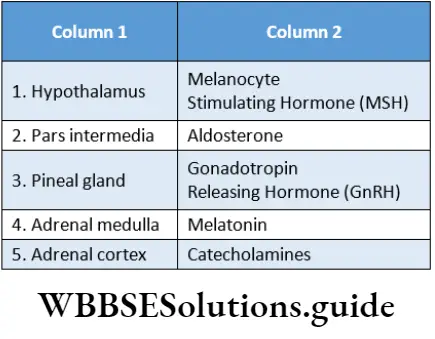
- 1-5,2-1,3-4,4-2,5-3
- 1-5,2-4,3-1,4-2,5-3
- 1-3,2-1,3-4,4-2,5-5
- 1-3,2-1,3-4,4-5,5-2
Answer: 4. 1-3,2-1,3-4,4-5,5-2
Question 24. Which of the following statements is wrong?
- Sella turcica is a bony cavity where the pituitary gland is located
- The parathyroid hormone decreases the Ca2+ levels in the blood
- Thymosins play a major role in T-cell differentiation
- The middle layer of the adrenal cortex is the zona fasciculata
- Insulin stimulates Glycogenesis
Answer: 2. Parathyroid hormone decreases the Ca2+ levels in blood
Question 25. An endocrine gland in humans, which plays an important role in the regulation of the rhythm of the body is-
- Adrenal gland
- Pineal gland
- Thymus
- Thyroid gland
Answer: 2. Pineal gland
Question 26. Insulin causes rapid movement of glucose from the blood to hepatocytes and adipocytes resulting in—
- Hyperglycemia
- Hypoglycemia
- Diabetes
- None of these
Answer: 2. Hypoglycemia
Question 27. Identify the hormones, A, B, and C that are labeled in the given flowchart—
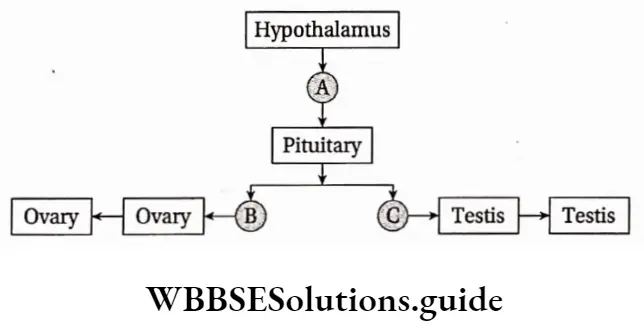
- 1-GnRH 2-ICSH 3-FSH
- 1-GH 2-FSH 3-LH
- 1-GnRH 2-PRL 3-ICSH
- 1-GnRH 2-FSH 3-LH
Answer: 4. 1-GnRH 2-FSH 3-LH
Question 28. Which one of the following hormones also produces anti-inflammatory reactions in man and suppresses the immune response in addition to its primary functions?
- Cortisol
- Thymosin
- Thyrocalcitonin
- Erythropoietin
Answer: 1. Cortisol
Question 29. Match the following columns:
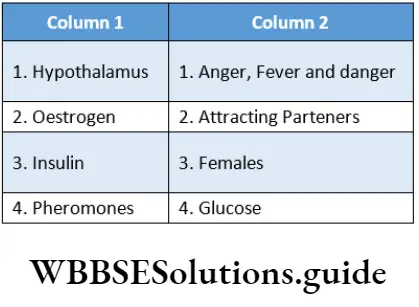
- 1-3,2-1,3-4,4-2
- 1-1,2-3,3-2,4-4
- 1-1,2-3,3-4,4-2
- 1-3,2-1,3-2,4-4
Answer: 3. 1-1,2-3,3-4,4-2
Question 30. The Hormone Responsible For Fight And fight-and-fight response is
- Adtenaline
- Thyrocine
- ADH
- Oxytocin
Answer: 1. Adtenaline
Question 31. Name The Hormome that has no role in menstruation
- LH
- FSH
- GH
- TSH
Answer: 3. GH
Question 32. Select the answer which correctly matches the endocrine gland with the hormone it secretes and its function/deficiency symptom.
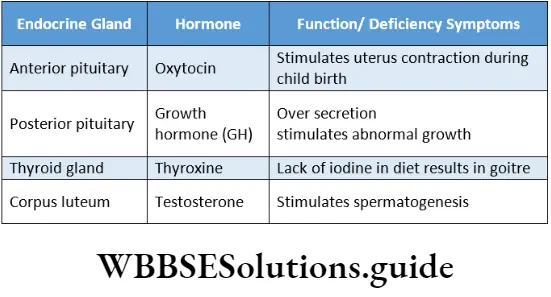
Answer: 3.
Question 33. Which of the following statements is correct in relation to the endocrine system?
- The adenohypophysis is under direct neural regulation of the hypothalamus.
- Organs in the body gastrointestinal tract, heart, kidney, and liver do not produce any hormones.
- Non-nutrient chemicals produced by the body in trace amounts that act as intercellular messenger are known as hormones.
- Releasing and inhibitory hormones are produced by the pituitary gland.
Answer: 3. Non-nutrient chemicals produced by the body in trace amount that act as intercellular messenger are known as hormones.
Quiz on chemical coordination and integration with correct answers
Question 34. Removal or absence of thymus in early life shall bring about—
- Lack of lymphocytes
- Lack of antibodies
- Lack of lymph nodes
- Both 1 and 2
Answer: 4. Both 1 and 2
Question 35. Gland responsible for calcium metabolism is—
- Thymus
- Thyroid
- Parathyroid
- Adrenal
Answer: 3. Parathyroid
Question 36. The Leydig cells secrete—
- Oestrogen
- Testosterone
- Progesterone
- Corticosterone
Answer: 2. Testosterone
